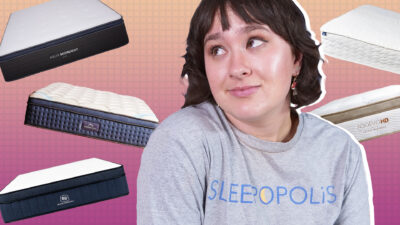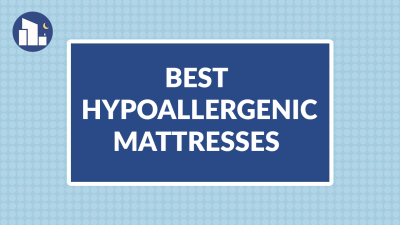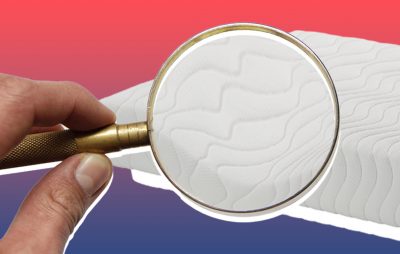Fiberglass is often used in mattresses as a flame retardant and is meant to be safe, but many people are wary of having it in their beds since it can cause health concerns if exposed. Because it’s a common and inexpensive material for manufacturers to use, finding the best mattress without fiberglass is not always an easy task. For that reason, we’ve put together this roundup of the best mattresses without fiberglass. The majority of these mattress are eco-friendly and organic as well, which we will outline in our mini reviews on each one. We’ll also discuss the use of fiberglass mdore thoroughly in our guide at the bottom.
In addition to being fiberglass-free, we made sure to include mattresses that can work for a wide variety of sleepers. This means testing mattress based on their pressure relief, firmness, motion isolation, cooling, and edge support. We’ve also included mattresses that are specifically geared toward heavy sleepers (those over 250 pounds) and various sleeping positions. This includes side, back, stomach, and combination sleepers (those who like to switch positions throughout the night). No matter what your preference, we’re positive you’ll be able to use the information we’ve derived from our tests to find the best fit. Read more below to find out which fiberglass-free mattress will match your individual needs.
Our Top Pick for the Best Mattress Without Fiberglass
The Bear Original gets the top spot on this list since it’s not only 100 percent fiberglass free, but it also is a very supportive, high-quality mattress designed for relaxation and recovery.
Best Mattresses Without Fiberglass
- Best Overall – Bear Original
- Best Mattress for Back Sleepers – Helix Midnight Luxe
- Best Hybrid Mattress – Bear Elite Hybrid
- Best Mattress for Stomach Sleepers – Helix Dawn
- Best Organic Mattress – Birch
- Best Mattress for Heavy Sleepers – Emma Hybrid Comfort
- Best Latex Mattress – Nolah Natural
- Best Cooling Mattress – Brooklyn Bedding Aurora Luxe
- Best Firm Mattress – Plank Firm
Best Mattresses Without Fiberglass 2024 Video Review
Compare the Best Mattresses Without Fiberglass
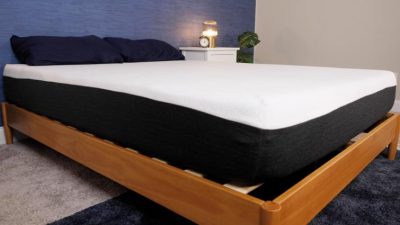
|
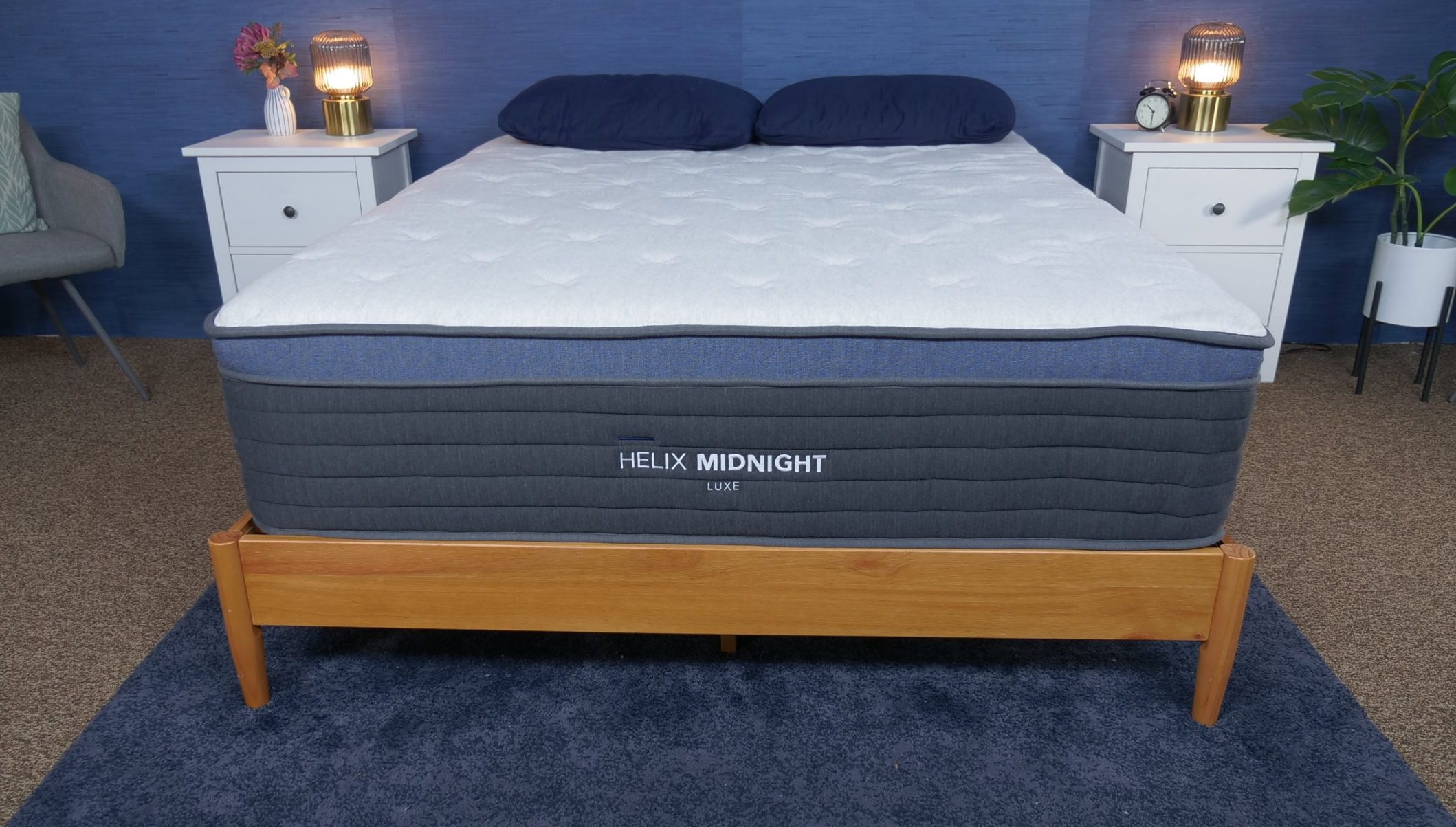
|
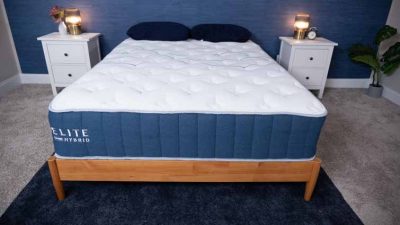
|
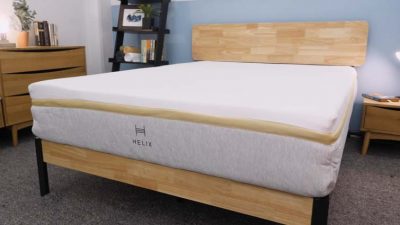
|
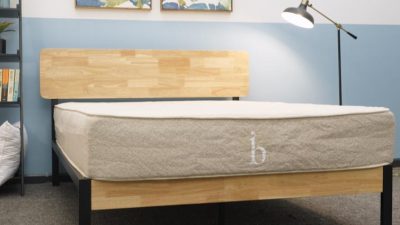
|
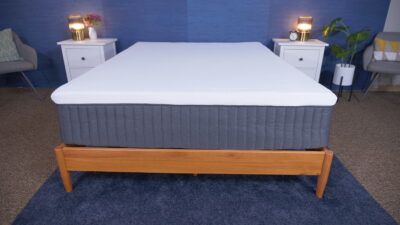
|
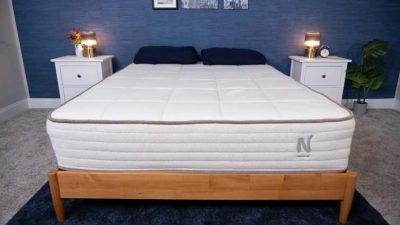
|
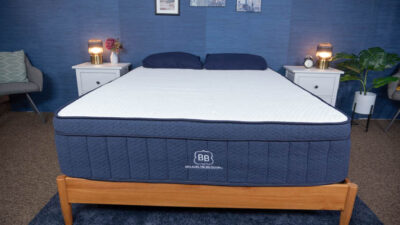
|
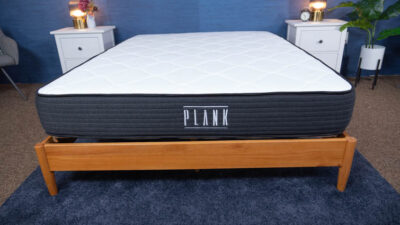
|
|
| Bear Original Mattress | Helix Midnight Luxe Mattress | Bear Elite Hybrid Mattress | Helix Dawn Mattress | Birch Natural Mattress | Emma Hybrid Comfort | Nolah Natural Mattress | Brooklyn Bedding Aurora Luxe Mattress | Brooklyn Bedding Plank Firm Mattress | |
| Rating | |||||||||
| Firmness | Firm: 7.5/10 | Medium-soft: 6/10 | Multiple firmness options | Firm: 7.5/10 | Medium-firm: 7/10 | Firm: 7.5/10 | Medium-soft: 6/10 | Multiple firmness options | Multiple firmness options |
| Material | Foam | Hybrid | Hybrid | Hybrid | Hybrid | Hybrid | Latex | Hybrid | Foam |
| Cooling | ✓ | -- | ✓ | -- | ✓ | ✓ | ✓ | ✓ | -- |
| Sleep Position | Back & Side | Combination | Back & Stomach | Back & Stomach | Back & Stomach | Back & Stomach | Combination | Back & Side | Back & Stomach |
Best Overall Mattress – Bear Original
We appreciate the firm and responsive feel of the Bear mattress. Its combination of support and pressure relief makes it an awesome option for anyone struggling with back pain. The Celliant cover also does a great job of keeping the mattress cool.
We recommend this mattress for the following sleeper types: Financing options are available for this mattress. We appreciate the firm and responsive feel of the Bear mattress. Its combination of support and pressure relief makes it an awesome option for anyone struggling with back pain. The Celliant cover also does a great job of keeping the mattress cool.
We recommend this mattress for the following sleeper types: Financing options are available for this mattress. We appreciate the firm and responsive feel of the Bear mattress. Its combination of support and pressure relief makes it an awesome option for anyone struggling with back pain. The Celliant cover also does a great job of keeping the mattress cool.
We recommend this mattress for the following sleeper types: Financing options are available for this mattress.Bear Original Mattress

Material
Foam
Trial Period
120 nights
Shipping Method
Free shipping
Firmness
Firm: 7.5/10
Warranty
Lifetime warranty
Price Range
$$$$$
Hot Sleepers
If you often overheat while you sleep, this mattress should help you stay cool.
Back Sleeping
Ideal for lightweight and average weight back sleepers.
Side Sleeping
Ideal for lightweight and average weight side sleepers.
Financing Options
Bear Original Mattress

Material
Foam
Warranty
Lifetime warranty
Firmness
Firm: 7.5/10
Shipping Method
Free shipping
Trial Period
120 nights
Price Range
$$$$$
Hot Sleepers
If you often overheat while you sleep, this mattress should help you stay cool.
Back Sleeping
Ideal for lightweight and average weight back sleepers.
Side Sleeping
Ideal for lightweight and average weight side sleepers.
Financing Options

Bear Original Mattress
Material
Foam
Firmness
Firm: 7.5/10
Trial Period
120 nights
Warranty
Lifetime warranty
Shipping Method
Free shipping
Price Range
$$$$$
Hot Sleepers
If you often overheat while you sleep, this mattress should help you stay cool.
Back Sleeping
Ideal for lightweight and average weight back sleepers.
Side Sleeping
Ideal for lightweight and average weight side sleepers.
Financing Options
Pros of the Bear Mattress
The Bear’s firm and supportive feel makes it ideal for back sleepers
It doesn’t offer much sinkage, a benefit for those who prefer to feel “on top” of the bed
The optimal Celliant cover gives this foam bed a cooling touch
The Bear isolates motion well, so couples won’t be too disturbed by each other’s movements
Cons of the Bear Mattress
This bed is not supportive enough to be one of the best mattresses for heavy sleepers, which accommodate folks weighing 250 pounds or more
The lack of sinkage means the Bear isn’t the best for cushioning or pressure relief, which is crucial for the best mattresses for side sleepers and the best mattresses for arthritis
The Bear is an affordable, all-foam bed with a firm feel that is best enjoyed by back sleepers. This bed keeps the sleeper “on top,” rather than sinking into the material. Designed with athletes in mind, the Bear has an optional Celliant cover, a material with a cool-to-the-touch feel that may promote recovery. Plus, this mattress is made in the United States. Watch our video review to learn more.
What our tester says:
“If you want a memory foam feel but don’t want to totally sink into it, this could be a good option for you. Though the Bear does have some sinkage and contouring, you won’t feel stuck in this mattress, which makes getting out of bed and switching positions easier.” – Bridget Chapman, former Sleepopolis senior product editor
Expert Opinion
The Bear Original is one of the only mattresses made specifically with athletes in mind. The secret? Celliant material in the cover. Studies show that it can help with active recovery by promoting blood flow and oxygen to your tissues. While Sleepopolis cannot personally say if this cover helps with athletes’ recovery time, we can attest to the cooling tendencies. Celliant helps to regulate your temperature, which is great for hot sleepers, or couples who have double the body heat in one bed. However, we do want to be honest with our customers and share that this cover is not included in the overall price of the Bear Original. It must be added at check out for an additional $130.
When we tested out the Bear Original, we were struck by its slightly firmer and supportive feel since it’s an all-foam mattress. We rated it a 7 on the firmness scale, which is created using the rankings of multiple Sleepopolis mattress testers. Because of this firm feel, the Bear Original gave us the sensation of sleeping on top of the bed, rather than sinking too far into it. That’s a mighty feat for a foam mattress, as foam beds usually tend to feel less supportive and durable than hybrid mattress or ones made from innersprings.
What our tester says: “The firm support of the Bear Original made me feel really comfortable while back sleeping. The bed kept me propped up, but the foams also offered nice sinkage and pressure relief around my lumbar region.” – Bridget Chapman, senior product editor
What Customers Say
After looking at the Bear website, the majority of reviewers commented on how well this mattress works for their younger children who are involved in athletics. Other users commented on how surprised they were by the comfort of this mattress despite the low price of the Bear Original.
Pros of the Bear Original
- The Bear Original is great for budget-friendly shoppers. Even before discounts, the Bear Original is priced under $1,000 for a queen-sized mattress.
- The two-inch section of graphite gel-infused memory foam has a slow-response to pressure. This is great for sleepers with back or joint pain, who will appreciate the contour and pressure relief that this mattress provides.
- With great motion transfer results, couples shouldn’t be able to feel the movements of their partner throughout the night. This is due to the top layer of memory foam included in the Bear Original, which keeps movement from spreading across the top of the mattress.
Cons of the Bear Original
- Heavier sleepers (those over 250 pounds) may not find the support they need from the Bear Original. Instead, these sleepers might want to opt for an innerspring mattress, which they can find in our roundup of best innerspring mattresses.
Bear Original’s Fiberglass-Free Construction
Bear says on its website, “None of our mattresses contain fiberglass. We use 100% fiberglass-free, OEKO-TEX certified, flame-retardant rayon. It’s chemical-free, safe, and effective, so you can breathe easy at night.”
Want to know more about the Bear Original? Check out our full Bear Original mattress review, or click here for our best deals on this mattress. For other budget-friendly mattress options, take a look at our roundup of the best mattresses.
Best Mattress for Back Sleepers – Helix Midnight Luxe
The Helix Midnight Luxe is a supportive mattress that's great for back sleepers. The Midnight Luxe’s thick comfort layer of memory foam provides plenty of pressure relief and contouring while the zoned coils offer a great deal of support.
We recommend this mattress for the following sleeper types: Financing options are available for this mattress. The Helix Midnight Luxe is a supportive mattress that's great for back sleepers. The Midnight Luxe’s thick comfort layer of memory foam provides plenty of pressure relief and contouring while the zoned coils offer a great deal of support.
We recommend this mattress for the following sleeper types: Financing options are available for this mattress. The Helix Midnight Luxe is a supportive mattress that's great for back sleepers. The Midnight Luxe’s thick comfort layer of memory foam provides plenty of pressure relief and contouring while the zoned coils offer a great deal of support.
We recommend this mattress for the following sleeper types: Financing options are available for this mattress.Helix Midnight Luxe Mattress

Material
Hybrid
Trial Period
100 nights
Shipping Method
Free shipping
Firmness
Medium-soft: 6/10
Warranty
15-year warranty
Price Range
$$$$$
Back Sleeping
Ideal for average weight and heavyweight back sleepers.
Side Sleeping
Ideal for average weight and heavyweight side sleepers.
Stomach Sleeping
Ideal for lightweight stomach sleepers.
Financing Options
Helix Midnight Luxe Mattress

Material
Hybrid
Warranty
15-year warranty
Firmness
Medium-soft: 6/10
Shipping Method
Free shipping
Trial Period
100 nights
Price Range
$$$$$
Back Sleeping
Ideal for average weight and heavyweight back sleepers.
Side Sleeping
Ideal for average weight and heavyweight side sleepers.
Stomach Sleeping
Ideal for lightweight stomach sleepers.
Financing Options

Helix Midnight Luxe Mattress
Material
Hybrid
Firmness
Medium-soft: 6/10
Trial Period
100 nights
Warranty
15-year warranty
Shipping Method
Free shipping
Price Range
$$$$$
Back Sleeping
Ideal for average weight and heavyweight back sleepers.
Side Sleeping
Ideal for average weight and heavyweight side sleepers.
Stomach Sleeping
Ideal for lightweight stomach sleepers.
Financing Options
Pros of the Helix Midnight Luxe
It sleeps cool, and its materials are designed to be breathable and cool to the touch
Under $2,000 for a queen, which is a great deal for a luxury mattress
Fans of soft mattresses should love this Helix model, it’s rated 6/10 on our firmness scale, which is softer than average
Cons of the Helix Midnight Luxe
Not firm enough to be the best mattress for stomach sleepers
Won’t be supportive enough for heavier sleepers over 250 pounds. These folks should check out the best mattresses for heavy people
The Helix Midnight Luxe is one of the six mattresses in the Helix Luxe line and is the brand’s take on a medium-firm hybrid mattress. It boasts a great balance of comfort and support, making it a great fit for back sleepers. The memory foam layers also provide some nice pressure relief and contouring that should help side sleepers feel supported on this mattress. If you want to learn more and see if this mattress is a good fit for you, check out our video review.
What our tester says:
“I love that the Helix Midnight Luxe offers solid edge support — you can use the whole bed! It also has great motion isolation, which makes it a nice option for couples.” – Bridget Chapman, former Sleepopolis senior product editor
Expert Opinion
The Helix Midnight Luxe is a hybrid mattress that features plush memory foam constructed over pocketed coils for a balance of pressure relief and support. This combination creates a medium-soft to medium-firm feel in the Helix Midnight Luxe that is especially important for both back and side sleepers. These sleepers need enough support to keep their spine in a neutral alignment. Luckily for them, the Helix Midnight Luxe includes an entire support layer of individually wrapped coils. This gives the mattress enough durability to keep sleepers lifted during the night.
However, back sleepers also need pressure relief around their lumbar region and shoulders. The comfort layer included in the Helix Midnight Luxe is made of memory foam, which helps to relieve added pressure around the joints and contour the body where it needs it most. This hybrid mattress also sleeps cool and has high breathability, offering an added bonus to sleepers that might suffer from night sweats, or to those who sleep with a partner and have double the body heat in their bed.
What our tester says: “I really like this bed for combination sleepers. The mattress is bouncy, making it easy for you to roll over or switch positions at night without worrying that you’ll get “stuck” in the bed. I think the luxe version is a great option for anyone looking to have all the benefits of the original mattress model — but with added plushness and support.” – Bridget Chapman, senior product editor
What Customers Say
Many customers on the reviews section of the Helix website praised the Helix Midnight Luxe for its plush feel, with some comparing it to sleeping on a cloud. Other users also noted how well this mattress helped to alleviate their back pain, which many attributed to the pillow top included on the Helix Midnight Luxe.
Pros of the Helix Midnight Luxe
- Sleepers who suffer from shoulder pain should feel comfortable on the Helix Midnight Luxe because it includes cushioning that prevents stiffness around the joints. This same cushioning also helps to relieve hip pain. However, side sleepers with hip pain might want to check out a softer mattress for more cushioning.
- The Helix Midnight Luxe does a fantastic job isolating motion, which can be seen in the motion transfer test results. This is great for couples because one partner shouldn’t be able to feel the movement of the other during the night.
- The Helix Midnight Luxe is also a great mattress for sex because of the bounciness of the individually wrapped coils included in its construction. This makes the bed easy to move around and switch positions on top of.
Cons of the Helix Midnight Luxe
- Heavier sleepers (those over 250 pounds) most likely won’t get the support they need from the Helix Midnight Luxe because of how soft this mattress is. These sleepers will need to opt for a mattress designed for larger body types, which they might be able to find on our best mattresses for heavier sleepers page.
Helix’s Fiberglass-Free Construction
Helix says on its website that “Every Helix mattress is made without the use of fiberglass. All Helix mattresses are designed with a fire retardant yarn made from a chemical-free Rayon barrier that is in the form of a small foam layer. Rayon fiber is a manufactured fiber composed of 100% regenerated cellulose.”
Read our full Helix Midnight Luxe review, or click here to find our best deals. If you want to see more options, take a look at our best mattresses for back sleepers page.
Best Hybrid Mattress – Bear Elite Hybrid
The Bear Elite Hybrid is Bear's “ultra-luxurious” model with a traditional mattress feel, plus advanced cooling and support technology. It comes in three different firmness levels: Soft, Medium, and Firm.
We recommend this mattress for the following sleeper types: Financing options are available for this mattress. Love it! I absolutely love this mattress and the adjustable frame. It’s helping my back issues so much. I highly recommend this mattress to anyone with back pain
The Bear Elite Hybrid is Bear's “ultra-luxurious” model with a traditional mattress feel, plus advanced cooling and support technology. It comes in three different firmness levels: Soft, Medium, and Firm.
We recommend this mattress for the following sleeper types: Financing options are available for this mattress. Love it! I absolutely love this mattress and the adjustable frame. It’s helping my back issues so much. I highly recommend this mattress to anyone with back pain
The Bear Elite Hybrid is Bear's “ultra-luxurious” model with a traditional mattress feel, plus advanced cooling and support technology. It comes in three different firmness levels: Soft, Medium, and Firm.
We recommend this mattress for the following sleeper types: Financing options are available for this mattress. Love it! I absolutely love this mattress and the adjustable frame. It’s helping my back issues so much. I highly recommend this mattress to anyone with back pain
Bear Elite Hybrid Mattress

Material
Hybrid
Trial Period
120 nights
Shipping Method
Free shipping
Firmness
Multiple firmness options
Warranty
Lifetime Warranty
Price Range
$$$$$
Hot Sleepers
If you often overheat while you sleep, this mattress should help you stay cool.
Back Sleeping
Ideal for lightweight, average weight, and heavyweight back sleepers.
Stomach Sleeping
Ideal for lightweight and average weight stomach sleepers.
Financing Options
Bear Elite Hybrid Mattress

Material
Hybrid
Warranty
Lifetime Warranty
Firmness
Multiple firmness options
Shipping Method
Free shipping
Trial Period
120 nights
Price Range
$$$$$
Hot Sleepers
If you often overheat while you sleep, this mattress should help you stay cool.
Back Sleeping
Ideal for lightweight, average weight, and heavyweight back sleepers.
Stomach Sleeping
Ideal for lightweight and average weight stomach sleepers.
Financing Options

Bear Elite Hybrid Mattress
Material
Hybrid
Firmness
Multiple firmness options
Trial Period
120 nights
Warranty
Lifetime Warranty
Shipping Method
Free shipping
Price Range
$$$$$
Hot Sleepers
If you often overheat while you sleep, this mattress should help you stay cool.
Back Sleeping
Ideal for lightweight, average weight, and heavyweight back sleepers.
Stomach Sleeping
Ideal for lightweight and average weight stomach sleepers.
Financing Options
Pros of the Bear Elite Hybrid
Thick comfort layers provide lots of pressure relief while coils lift the hips for spinal support
The Medium model has a medium-soft feel that should suit most back and side sleepers
A responsive feel makes this bed easy to move on
Cons of the Bear Elite Hybrid
Heavyweight stomach sleepers won’t get enough support. See our best mattresses for heavy people for better options
As a luxury mattress with many special features, the Bear Elite Hybrid is priced higher. Budget shoppers may want to check out the best cheap mattresses instead
The Bear Elite Hybrid uses foam and coils for a mix of support, cushioning, and cooling. While designed for athletes prioritizing wellness and recovery, sleepers of all activity levels can enjoy the many luxurious features. Enjoy zoned support for targeted relief, an “on top of” feel allowing for ease of movement, and cooling features throughout. For more information, watch our video review.
What our tester says:
“I tested the Medium model and found that it’s a good match for most average-weight back and side sleepers. It has a balanced foam feel, and it offers a good blend of comfort and support.” – Bridget Chapman, former Sleepopolis senior product editor
Expert Opinion
Hybrid models have become really popular since their blend of materials offers the sought-after combination of support and pressure relief. When we tested out the fiberglass-free Bear Elite Hybrid — made with soft memory foam up top and sturdy coils at the bottom — we experienced all of the features that hybrids are known for: spinal support, a little bit of contouring, and plenty of cooling. We found it to be on the softer end, giving it a score of 6 out of 10 on our mattress firmness scale. That means the Bear Elite Hybrid is a bit plusher than most other beds, as the industry standard is set at 6.5 for a medium-firm mattress.
One of the most unique things about the Bear brand is that it caters to athletes. Like several of its models, the Elite Hybrid has a cover made of Celliant, a material designed to promote muscle recovery and blood flow. While we haven’t independently verified these claims, Celliant has undergone several clinical trials that you can read about here. We can confidently say that the Elite Hybrid has strong edge support, due to a reinforced perimeter of coils. So athletes can easily spread out on their bed after a workout.
What our tester says: “I honestly like a lot about the Bear Elite Hybrid mattress — starting with how you can choose your firmness level. I tested out the middle level (Medium) and I think it’s great that each sleeper can pick what option works best for them.” – Bridget Chapman, senior product editor
What Customers Say
The Elite Hybrid is newer than some of the other Bear models, so there aren’t as many reviews for it on the company’s website (about 330 as of this writing). But the ones that are there praise the different firmness levels and how they’re able to accommodate every sleeping position.
Pros of the Bear Elite Hybrid Mattress
- The Bear Elite Hybrid comes in three different firmness levels, so there’s something for every sleeping position. We think side sleepers will be most comfortable on the Soft model, back sleepers will be most comfortable on the Medium, and stomach sleepers will be most comfortable on the Firm.
- Another bonus of Celliant is that it sleeps incredibly cool. Between that and the airflow-promoting coils, we think the Bear Elite Hybrid is an excellent pick for hot sleepers or anyone looking to cool down after exercising.
- The Bear Elite Hybrid’s springs give it a lot of responsiveness. That means it should be easy for you to move around, making it a great mattress for combination sleepers who switch positions at night. Couples should also find that it’s a good mattress for sex.
Cons of the Bear Elite Hybrid Mattress
- Being a luxury option, the Bear Elite Hybrid is on the expensive side — something to keep in mind if you’re shopping on a budget.
Bear Elite Hybrid’s Fiberglass-Free Construction
Bear says on its website, “None of our mattresses contain fiberglass. We use 100% fiberglass-free, OEKO-TEX certified, flame-retardant rayon. It’s chemical-free, safe, and effective, so you can breathe easy at night.”
If this sounds like the hybrid mattress for you, check out our best deals here, or read our full Bear Elite Hybrid mattress review for more information. If you want more hybrid options, take a look at our roundup of the best hybrid mattresses on the market right now.
Best Mattress for Stomach Sleepers – Helix Dawn
The Helix Dawn is the firmest model Helix Sleep offers. It uses strong support to provide a great feel for back and stomach sleepers. The hybrid build provides good bounce and mobility so you’ll be able to change positions easily too.
We recommend this mattress for the following sleeper types: Financing options are available for this mattress. The Helix Dawn is the firmest model Helix Sleep offers. It uses strong support to provide a great feel for back and stomach sleepers. The hybrid build provides good bounce and mobility so you’ll be able to change positions easily too.
We recommend this mattress for the following sleeper types: Financing options are available for this mattress. The Helix Dawn is the firmest model Helix Sleep offers. It uses strong support to provide a great feel for back and stomach sleepers. The hybrid build provides good bounce and mobility so you’ll be able to change positions easily too.
We recommend this mattress for the following sleeper types: Financing options are available for this mattress.Helix Dawn Mattress

Material
Hybrid
Trial Period
100 nights
Shipping Method
Free shipping
Firmness
Firm: 7.5/10
Warranty
10-year warranty
Price Range
$$$$$
Couples
This bed has great motion isolation so you will not feel your partner tossing and turning at night.
Back Sleeping
Ideal for average weight back sleepers.
Stomach Sleeping
Ideal for lightweight and average weight stomach sleepers.
Financing Options
Helix Dawn Mattress

Material
Hybrid
Warranty
10-year warranty
Firmness
Firm: 7.5/10
Shipping Method
Free shipping
Trial Period
100 nights
Price Range
$$$$$
Couples
This bed has great motion isolation so you will not feel your partner tossing and turning at night.
Back Sleeping
Ideal for average weight back sleepers.
Stomach Sleeping
Ideal for lightweight and average weight stomach sleepers.
Financing Options

Helix Dawn Mattress
Material
Hybrid
Firmness
Firm: 7.5/10
Trial Period
100 nights
Warranty
10-year warranty
Shipping Method
Free shipping
Price Range
$$$$$
Couples
This bed has great motion isolation so you will not feel your partner tossing and turning at night.
Back Sleeping
Ideal for average weight back sleepers.
Stomach Sleeping
Ideal for lightweight and average weight stomach sleepers.
Financing Options
Pros of the Helix Dawn
Provides great lumbar support
Solid durability
Upgradeable to the more luxurious Helix Dawn Luxe
Cons of the Helix Dawn
This mattress doesn’t provide much pressure relief, which might be an issue if you’re someone with joint pain
It has poor motion isolation, so couples might feel each other’s movement
This mattress is too firm for side sleepers. They should take a look at our best mattress for side sleepers page
The Helix Dawn is one of the firmest mattresses offered by the company. Its construction provides good comfort for heavy people and stomach sleepers, both of whom need extra support to keep from sinking uncomfortably below the mattress surface. Like the other Helix mattresses, it can be upgraded to the Luxe version if you’re willing to pay a little extra for luxury features. To learn more, check out our video on Helix mattresses.
What our tester says:
“I really appreciate how supportive these mattresses are. Stomach sleepers, back sleepers, and heavy people (those over 250 pounds) could all benefit from the firm feel of this bed. No matter which model you choose, the Helix Dawn really delivers on lumbar support.” Logan Block, former Sleepopolis content director and mattress tester
Expert Opinion
Stomach sleepers usually require a lot more firmness and support than other sleeping positions. That’s because they put the most pressure on a mattress, and they need a bed strong enough to keep their hips from bowing into the layers and throwing their spine out of alignment. Fortunately, Helix has created a good match for them with the Helix Dawn.
The Dawn is one of six hybrid mattresses in the original Helix line, each one with a different level of firmness. When we tested it out, we scored it at a 7.5 out of 10 on our mattress firmness scale, which is indeed very firm. When turning over on our stomach, we felt lifted by the mattress’s layer of coils at the bottom. This tells us that stomach sleepers should feel supported on the Helix Dawn and, most importantly, comfortable.
“I really appreciate how supportive this mattress is. Stomach sleepers, back sleepers, and heavy people (those over 250 pounds) could all benefit from the firm feel of this bed.” – Logan Block, former content director
What Customers Say
On Helix’s website, the Dawn has a little over 1,200 reviews and an average customer rating of 4.4 out of 5 stars. Unsurprisingly, several folks talk about how they love the mattress’s firmness and its resistance to sagging.
Pros of the Helix Dawn Mattress
- Back sleepers should also be comfortable on the Helix Dawn, as long as they enjoy a firmer feel. The coils will help them maintain a neutral spinal alignment.
- The Helix Dawn has a soft cover that’s breathable, and the coils leave plenty of room for airflow. Both of these features help the bed sleep nice and cool, which should appeal to hot sleepers.
- Like all of the original Helix mattresses, the Dawn is available in a Luxe version. For an extra charge, you get upgraded features such as a Tencel cover and added pillow top.
Cons of the Helix Dawn Mattress
- The Helix Dawn is probably too firm for anyone who sleeps strictly on their side. If this sounds like you, check out our best mattresses for side sleepers for other options.
Helix Dawn’s Fiberglass-Free Construction
The Helix website has the following statement on fiberglass: “Every Helix mattress is made without the use of fiberglass. All Helix mattresses are designed with a fire retardant yarn made from a chemical-free Rayon barrier that is in the form of a small foam layer. Rayon fiber is a manufactured fiber composed of 100% regenerated cellulose.”
Check out our full Helix Dawn mattress review for more details, or see our best mattresses for stomach sleepers for more options. If you’re all in for the Helix Dawn mattress, click here for our best deal.
Best Organic Mattress – Birch
The Birch mattress is an all-natural bed that uses organic cotton and wool fibers to create a structure that’s as eco-friendly as it is cozy.
We recommend this mattress for the following sleeper types: Financing options are available for this mattress. The Birch mattress is an all-natural bed that uses organic cotton and wool fibers to create a structure that’s as eco-friendly as it is cozy.
We recommend this mattress for the following sleeper types: Financing options are available for this mattress. The Birch mattress is an all-natural bed that uses organic cotton and wool fibers to create a structure that’s as eco-friendly as it is cozy.
We recommend this mattress for the following sleeper types: Financing options are available for this mattress.Birch Natural Mattress

Material
Hybrid
Trial Period
100 nights
Shipping Method
Free shipping
Firmness
Medium-firm: 7/10
Warranty
25-year warranty
Price Range
$$$$$
Hot Sleepers
If you often overheat while you sleep, this mattress should help you stay cool.
Back Sleeping
Ideal for average weight back sleepers.
Stomach Sleeping
Ideal for average weight stomach sleepers.
Financing Options
Birch Natural Mattress

Material
Hybrid
Warranty
25-year warranty
Firmness
Medium-firm: 7/10
Shipping Method
Free shipping
Trial Period
100 nights
Price Range
$$$$$
Hot Sleepers
If you often overheat while you sleep, this mattress should help you stay cool.
Back Sleeping
Ideal for average weight back sleepers.
Stomach Sleeping
Ideal for average weight stomach sleepers.
Financing Options

Birch Natural Mattress
Material
Hybrid
Firmness
Medium-firm: 7/10
Trial Period
100 nights
Warranty
25-year warranty
Shipping Method
Free shipping
Price Range
$$$$$
Hot Sleepers
If you often overheat while you sleep, this mattress should help you stay cool.
Back Sleeping
Ideal for average weight back sleepers.
Stomach Sleeping
Ideal for average weight stomach sleepers.
Financing Options
Pros of the Birch Natural
Organic mattress with numerous GOTS and GREENGUARD Gold certifications
Naturally cooling Talalay latex in its transition layer
Enough firmness and strong support for anyone experiencing back pain
Enough responsiveness for combination sleeping
Ideal for anyone looking for a firmer, more “on top of the bed” feel
Cons of the Birch Natural
This isn’t one of the best mattresses for side sleepers, which have a softer feel that better cushions the joints
Higher price point — one of the best cheap mattresses might be better
You won’t find the slow sinkage many look for in the best memory foam mattress
The Birch Natural is a latex mattress utilizing individually wrapped coils for added support. This mattress specializes in cooling and responsiveness, and the firmer nature suits back and stomach sleepers well. Perhaps the most special part about this mattress is the material quality. Not only is the Birch organic, but it has also earned multiple certifications for safe production and materials. For more information, check out our video review.
What our tester says:
“One of my favorite things about the Birch is how cooling it is. I think any hot sleeper will be satisfied by this breathable bed. It’s definitely one of the most cooling mattresses available thanks to its wool and latex layers. These cooling materials also make it one of my favorite organic mattresses.” – Madison Schaper, Sleepopolis staff writer
Expert Opinion
Helix is known for its original lineup of hybrid mattresses, and they’ve since gotten into the organic game with the Birch. This is an 11-inch tall Talalay latex mattress that ranks at a seven on our firmness scale, making it slightly firmer than the industry standard. This mattress has a highly bouncy feel, which makes it a great pick for combination sleepers who need to be able to move on top of the mattress in order to switch into multiple positions throughout the night. The Birch is also a great mattress for sex because of this bouncy, responsive feel.
The Birch is constructed using organic cotton and wool fibers. It is Greenguard Gold certified, so this mattress wasn’t made using high levels of chemical emissions or volatile organic compounds. The quilted fibers in the Birch also make the material fire-retardant, which is great for a bed that does include any fiberglass in its construction.
What our tester says: “One of my favorite things about the Birch is how cooling it is! I think any hot sleeper will be satisfied by this breathable bed. It’s definitely one of the most cooling mattresses available thanks to its wool and latex layers.” – Madison Schaper, former Sleepopolis staff writer and mattress tester
What Customers Say
The majority of customers on the Helix website commented on how little back pain they had after spending a few nights sleeping on the Birch. Other users talked about how much they appreciated the natural materials used in the Birch, and Helix’s commitment to eco-friendly mattresses in general.
Pros of the Birch
- The organic materials and pocketed coil system used in the construction of the Birch make it particularly breathable, which is great for both hot sleepers and couples who want to make sure they don’t wake up sweaty. The natural wool used in the Birch also prevents this mattress from trapping any body heat, adding to the cooling feel.
- The Birch is great for lightweight sleepers who don’t want to “sink” into their mattress. Lightweight back and stomach sleepers should especially enjoy the Birch because it should keep them uplifted so their hips can stay in line with their shoulders, promoting a healthy spinal alignment.
- The Birch is also a great mattress for sleepers who suffer from back pain because of its results on our pressure map. While on our back, the results lit up entirely blue during the pressure map test (meaning low pressure), so sleepers with back pain should be comfortable.
Cons of the Birch
- Sleepers suffering from hip pain will need a softer mattress than the Birch. The longer you lay on this mattress on your side, the more pressure digs into your shoulders and hips, which can be seen during the pressure map test. Because of this, side sleepers with hip pain might want to check out our roundup of the best mattresses with pillow tops to get some added pressure relief for their joints.
Birch’s Fiberglass-Free Construction
The company says they don’t rely on plastics or fiberglass materials for the fire-retardant layer in their mattresses. “There are numerous benefits of wool in our organic mattresses. Not only is it extremely comfortable, but wool fibers also provide a natural insulator so your body temperature stays regulated, and you stay asleep all night,” its website says. “In addition, our wool is naturally flame-resistant which makes it one of the safest fire-safety fibers to use in a mattress.”
If you’re set on the Birch, click here to get our best deals, or read our full Birch mattress review. Still looking? Take a look at our best organic mattresses roundup to see some other eco-friendly options.
Best Latex Mattress – Nolah Natural
The Nolah Natural mattress is not only made with eco-friendly and hypoallergenic materials, but it also offers pressure relief and comfort that many sleepers should enjoy.
We recommend this mattress for the following sleeper types: Financing options are available for this mattress. The Nolah Natural mattress is not only made with eco-friendly and hypoallergenic materials, but it also offers pressure relief and comfort that many sleepers should enjoy.
We recommend this mattress for the following sleeper types: Financing options are available for this mattress. The Nolah Natural mattress is not only made with eco-friendly and hypoallergenic materials, but it also offers pressure relief and comfort that many sleepers should enjoy.
We recommend this mattress for the following sleeper types: Financing options are available for this mattress.Nolah Natural Mattress

Material
Latex
Trial Period
120 Nights
Shipping Method
Free shipping
Firmness
Medium-soft: 6/10
Warranty
Lifetime warranty
Price Range
$$$$$
Hot Sleepers
If you often overheat while you sleep, this mattress should help you stay cool.
Back Pain
This bed is perfect for anyone suffering from back pain.
Back Sleeping
Ideal for lightweight, average weight, and heavyweight back sleepers.
Side Sleeping
Ideal for lightweight, average weight, and heavyweight side sleepers.
Stomach Sleeping
Ideal for lightweight stomach sleepers.
Financing Options
Nolah Natural Mattress

Material
Latex
Warranty
Lifetime warranty
Firmness
Medium-soft: 6/10
Shipping Method
Free shipping
Trial Period
120 Nights
Price Range
$$$$$
Hot Sleepers
If you often overheat while you sleep, this mattress should help you stay cool.
Back Pain
This bed is perfect for anyone suffering from back pain.
Back Sleeping
Ideal for lightweight, average weight, and heavyweight back sleepers.
Side Sleeping
Ideal for lightweight, average weight, and heavyweight side sleepers.
Stomach Sleeping
Ideal for lightweight stomach sleepers.
Financing Options

Nolah Natural Mattress
Material
Latex
Firmness
Medium-soft: 6/10
Trial Period
120 Nights
Warranty
Lifetime warranty
Shipping Method
Free shipping
Price Range
$$$$$
Hot Sleepers
If you often overheat while you sleep, this mattress should help you stay cool.
Back Pain
This bed is perfect for anyone suffering from back pain.
Back Sleeping
Ideal for lightweight, average weight, and heavyweight back sleepers.
Side Sleeping
Ideal for lightweight, average weight, and heavyweight side sleepers.
Stomach Sleeping
Ideal for lightweight stomach sleepers.
Financing Options
Pros of the Nolah Natural
This bed is made with natural materials, a pro for eco-conscious shoppers
Latex and coils make this bed bouncy and responsive, so it’s easy to move around on
These materials also keep the Nolah Natural sleeping very cool
The Nolah Natural is supportive enough for people of all weights
Cons of the Nolah Natural
The Nolah Natural is too soft for most stomach sleepers. They’d be better off checking out our best mattresses for stomach sleepers instead
The bouncy feel also means motion transfers across this bed, so you may feel a partner’s movements. Something on our best mattress for couples page might be a better fit
The Nolah Natural is an eco-friendly bed with a luxurious feel. It’s soft but buoyant feel works well for back and side sleepers, but is a bit too soft for stomach sleepers. The combination of naturally-cool latex, airflow-promoting coils, and breathable cotton keeps this bed sleeping nice and cool. It has a supportive and sturdy feel, meaning it can support people of varying weights. Learn more in our video review.
What our tester says:
“It has a very soft, plush feel that provides you some cushioning as well. I’d say you’re going to feel more ‘on top’ of this bed than ‘in it’ — thanks to its bouncy latex.” – Bridget Chapman, former Sleepopolis senior product editor
Expert Opinion
The Nolah Natural is an 11″ mattress made from natural materials, which is especially important for eco-friendly shoppers. This hybrid mattress is hypoallergenic and includes GOTS (Global Organic Textile Standard) certified organic wool, GOTS certified organic cotton, recycled steel, and Talalay latex in its construction. It ranks at a 6 on our firmness scale, making it slightly softer than the industry standard of 6.5 for medium firmness.
The cover of the Nolah Natural includes organic wool that’s moisture-wicking and creates a natural fire barrier. This is especially important for a mattress that does not contain any fiberglass. The hybrid construction of the Nolah Natural also allows for more airflow throughout the mattress, helping with breathability and preventing the build-up of body heat.
What our tester says: “I felt so cozy on the Nolah Natural. Its two layers of latex kept me propped up and supported, but also offered some nice contouring around my joints. I think combination sleepers could really enjoy this bed too since it’s easy to move around on.” – Bridget Chapman, senior product editor
What Customers Say
Many folks on the Nolah website commented on how much they appreciate a mattress made from entirely eco-friendly materials. Other users stated that the Nolah Natural was more comfortable than hotel mattresses that they have slept on in the past.
Pros of the Nolah Natural
- Heavier sleepers that prefer to sleep on their side or back should enjoy the support and pressure relief that the softness of the Nolah Natural offers.
- Sleepers with back pain should appreciate the pressure relief that the Nolah Natural offers. Our Sleepopolis mattress testers spread a pressure map over the bed and lay in different sleeping positions, showing how much pressure is exerted on the mattress. For back sleeping, the pressure map was completely blue (meaning low pressure).
- Since the Nolah Natural includes coils and latex in its hybrid construction, it is a good mattress for sex because it is bouncy and responsive to movements on top of the bed.
Cons of the Nolah Natural
- This is a soft mattress, so strict stomach sleepers will want to opt for a firmer mattress that will keep their hips lifted in line with their shoulders, promoting a healthy spinal alignment. Take a look at our best mattresses for stomach sleepers to find a firmer mattress.
Nolah’s Fiberglass-Free Construction
The company says on its website, “Nolah is committed to our customers’ comfort and safety, and all our mattresses are 100% fiberglass-free. Rigorous testing and strict certifications demonstrate the safety of all materials used in our mattresses. Our AirFoam™ mattresses (Nolah Original, Signature, and Evolution) are CertiPUR-US® certified and free from ozone depleters, heavy metals, and chemical fire retardants. Our latex hybrid mattresses (Nolah Natural and Nurture) are Global Organic Textile Standard (GOTS) and OEKO-TEX 100 Class 1 certified; they test free of harmful chemicals and substances.”
Ready to go natural? Click here to find our best deals for the Nolah Natural. Need more information? Read our full Nolah Natural mattress review, or check out our roundup of the best organic mattresses for more options.
Best Mattress for Heavy Sleepers – Emma Hybrid Comfort
The Emma Hybrid Comfort is a firm, supportive, and bouncy mattress. A good fit for back sleepers and stomach sleepers, it also has open-celled foam for cooling.
We recommend this mattress for the following sleeper types: Financing options are available for this mattress. The Emma Hybrid Comfort is a firm, supportive, and bouncy mattress. A good fit for back sleepers and stomach sleepers, it also has open-celled foam for cooling.
We recommend this mattress for the following sleeper types: Financing options are available for this mattress. The Emma Hybrid Comfort is a firm, supportive, and bouncy mattress. A good fit for back sleepers and stomach sleepers, it also has open-celled foam for cooling.
We recommend this mattress for the following sleeper types: Financing options are available for this mattress.Emma Hybrid Comfort

Material
Hybrid
Trial Period
365 nights
Shipping Method
Free shipping
Firmness
Firm: 7.5/10
Warranty
10-year warranty
Price Range
$$$$$
Hot Sleepers
If you often overheat while you sleep, this mattress should help you stay cool.
Back Sleeping
Ideal for average weight and heavyweight back sleepers.
Stomach Sleeping
Ideal for lightweight and heavyweight stomach sleepers.
Financing Options
Emma Hybrid Comfort

Material
Hybrid
Warranty
10-year warranty
Firmness
Firm: 7.5/10
Shipping Method
Free shipping
Trial Period
365 nights
Price Range
$$$$$
Hot Sleepers
If you often overheat while you sleep, this mattress should help you stay cool.
Back Sleeping
Ideal for average weight and heavyweight back sleepers.
Stomach Sleeping
Ideal for lightweight and heavyweight stomach sleepers.
Financing Options

Emma Hybrid Comfort
Material
Hybrid
Firmness
Firm: 7.5/10
Trial Period
365 nights
Warranty
10-year warranty
Shipping Method
Free shipping
Price Range
$$$$$
Hot Sleepers
If you often overheat while you sleep, this mattress should help you stay cool.
Back Sleeping
Ideal for average weight and heavyweight back sleepers.
Stomach Sleeping
Ideal for lightweight and heavyweight stomach sleepers.
Financing Options
Pros of the Emma Hybrid Comfort
Great motion isolation makes it a good choice for couples
A bouncy feel makes it easy to move around on
An airy hybrid construction keeps the mattress cool
Cons of the Emma Hybrid Comfort
Too firm for side sleepers, who won’t receive adequate pressure relief on the shoulder and hip. We suggest looking at the best mattresses for side sleepers instead
Edge support didn’t impress us — you may not feel supported if you sit or lie along the edge. Some of our favorite options for edge support are in our best mattresses that won’t sag roundup
The Emma Hybrid Comfort is a firm mattress with a durable hybrid construction. It works well for heavyweight stomach and back sleepers, as it provides enough support to keep these sleepers’ spines in neutral alignment. In addition to making it a good choice for heavier people, the Emma Hybrid Comfort’s design also gives it nice breathability and responsiveness, meaning it stays cool as you sleep and is easy to move around on.
What our tester says:
“After five minutes of lying on the Emma Hybrid Comfort, it increased 7.7 degrees. This indicates good temperature regulation. I really did feel cool when resting on it. Considering this, the airy hybrid construction, and the additional cooling features, I feel that the Emma Hybrid Comfort is one of the best cooling mattresses.” – Amelia Jerden, senior staff writer
A Note On Weight and Body Type
We recognize that people come in all shapes and sizes, and people of every size deserve a mattress that works for their body type. We use the weight categories light, average, and heavy to more easily categorize sleepers based on how mattresses will perform for their body type, as most mattresses are designed for the group we call “average” (130 to 250 pounds). We consider heavy sleepers to be anyone over 250 pounds, and they tend to need more support to prevent them from sinking too far into the layers.
Expert Opinion
The Hybrid Comfort is one of the newest fiberglass-free creations from Emma. With three sturdy layers, it’s built with cooling foam, firmer high-density foam, and a base of ergonomic coils that are supportive enough to hold up heavier weights over 250 pounds. We also ranked it at a 7.5 on our firmness scale, so it’s firmer than most other beds on the market. However, heavier sleepers should also get pressure relief in addition to stability and durability.
Couples should also appreciate the construction of this mattress, since a bed with two people is going to need extra support. Luckily, the Emma Hybrid Comfort is specifically designed with solid edge support. Our Sleepopolis testers did not feel any sagging or sinkage when they laid at the edge, which is great for couples who like to spread out and use the entire surface area of their mattress.
What our tester says: “Heavier sleepers who sleep on their back or stomach should sleep well on this mattress since it’ll keep their back and hips properly aligned with their spine.” – Amelia Jerden, senior product editor
What Customers Say
The Emma Hybrid Comfort is a brand-new mattress, so there aren’t a whole lot of customer reviews on the brand’s website just yet. However, the ones that are there praise the company’s expedient delivery and 365-night trial.
Pros of the Emma Hybrid Comfort Mattress
- Sleepers with back pain should appreciate the Hybrid Comfort’s support, which will help keep their spine in alignment during the night.
- The Emma Hybrid Comfort did well on our responsiveness test. It should be easy to move around the mattress, which is great news for those wanting a good mattress for sex or combination sleeping.
- Couples should appreciate the Emma Hybrid Comfort’s motion transfer results. With good motion isolation, couples shouldn’t feel the tossing and turning of their partner during the night.
Cons of the Emma Hybrid Comfort Mattress
- While heavy back sleepers and stomach sleepers should be happy on the Emma Hybrid Comfort, strict side sleepers with joint pain will want to go for a softer mattress in order to get more pressure relief around their hips and shoulders. Take a look at our roundup of the best mattresses for hip pain.
Emma Hybrid Comfort’s Fiberglass-Free Construction
When we reached out to Emma via email about whether or not their mattresses contain fiberglass, this was their reply: “Rest assured that the Emma Hybrid Comfort mattress does not contain fiberglass. We prioritize the use of high-quality and safe materials to ensure your comfort and peace of mind. Instead of fiberglass, we utilize alternative materials in our construction to provide you with the support and comfort you expect from an Emma mattress.”
Read our full Emma Hybrid Comfort mattress review if you want a more detailed explanation of this mattress. If you’re ready to buy, click here for our best deals, or check out at our roundup of the best mattresses for heavy people to see other options.
Best Cooling Mattress – Brooklyn Bedding Aurora Luxe
The Brooklyn Bedding Aurora Luxe is a hybrid bed-in-a-box mattress. It comes in three firmness levels and with an optional Cloud Pillow Top, so sleepers can pick the best model for their needs. It also has cooling tech in nearly every layer, which means it sleeps super cool!
We recommend this mattress for the following sleeper types: Financing options are available for this mattress. The Brooklyn Bedding Aurora Luxe is a hybrid bed-in-a-box mattress. It comes in three firmness levels and with an optional Cloud Pillow Top, so sleepers can pick the best model for their needs. It also has cooling tech in nearly every layer, which means it sleeps super cool!
We recommend this mattress for the following sleeper types: Financing options are available for this mattress. The Brooklyn Bedding Aurora Luxe is a hybrid bed-in-a-box mattress. It comes in three firmness levels and with an optional Cloud Pillow Top, so sleepers can pick the best model for their needs. It also has cooling tech in nearly every layer, which means it sleeps super cool!
We recommend this mattress for the following sleeper types: Financing options are available for this mattress.Brooklyn Bedding Aurora Luxe Mattress

Material
Hybrid
Trial Period
120 nights
Shipping Method
Free shipping
Firmness
Multiple firmness options
Warranty
10-year warranty
Price Range
$$$$$
Hot Sleepers
If you often overheat while you sleep, this mattress should help you stay cool.
Back Pain
This bed is perfect for anyone suffering from back pain.
Side Sleeping
Ideal for average weight side sleepers.
Financing Options
Brooklyn Bedding Aurora Luxe Mattress

Material
Hybrid
Warranty
10-year warranty
Firmness
Multiple firmness options
Shipping Method
Free shipping
Trial Period
120 nights
Price Range
$$$$$
Hot Sleepers
If you often overheat while you sleep, this mattress should help you stay cool.
Back Pain
This bed is perfect for anyone suffering from back pain.
Side Sleeping
Ideal for average weight side sleepers.
Financing Options

Brooklyn Bedding Aurora Luxe Mattress
Material
Hybrid
Firmness
Multiple firmness options
Trial Period
120 nights
Warranty
10-year warranty
Shipping Method
Free shipping
Price Range
$$$$$
Hot Sleepers
If you often overheat while you sleep, this mattress should help you stay cool.
Back Pain
This bed is perfect for anyone suffering from back pain.
Side Sleeping
Ideal for average weight side sleepers.
Financing Options
Pros of the Aurora Luxe
The coils allow for airflow, the cover uses material that’s cool to the touch, and the foam has a gel infusion to fight heat
The Medium version works well for side sleepers
Its hybrid construction makes it easy to move around on
Cons of the Aurora Luxe
The Medium is too soft for stomach sleepers. They should opt for the Firm version or shop from our roundup of the best mattresses for stomach sleepers
It won’t have that slow-moving feel to it, like the best memory foam mattress might
The Brooklyn Bedding Aurora Luxe mattress is one of Brooklyn Bedding’s more high-end mattresses. It’s got a ton of cooling features in it that can help hot sleepers sleep cool all night. It’s another one of Brooklyn Bedding’s mattresses that has firmness options, but the medium model is a great choice for side sleepers who need pressure relief. For more information, check out our video review.
What our tester says:
“The Aurora Luxe is one of those mattresses that you know is cooling just by touching the cover. Seriously, it’s cool to the touch. I found the Medium model to be really comfy for both back and side sleeping.” – Bridget Chapman, former Sleepopolis senior product editor
Expert Opinion
No one wants a mattress that traps heat so easily that they wake up hot and sweaty. During testing, we discovered that the Brooklyn Bedding Aurora Luxe is one of the finest cooling mattresses on the market. It has a cover made with Phase Change Material (PCM), which works to regulate your body temperature. We found that this fabric is quite literally cool to the touch. Beneath is a comfort foam built for pressure relief; this also contains more PCM for even more cooling. The support layer of pocketed coils at the bottom of the mattress allows for plenty of airflow. There’s also an optional Cloud Pillow Top offered for an additional fee, which can be helpful for those who sleep extra hot or those who need a lot of pressure relief.
There are also three separate firmnesses shoppers can choose from: Soft, Medium, and Firm. So, you can select the bed that’s best for your body weight and sleeping preferences. For what it’s worth, we tested the Firm.
What our tester says: “My favorite thing about this bed is how cooling it is. Even some of the best soft mattresses tend to sleep a little hot because of the snuggly foams they use. The Aurora Luxe really solves this problem with Phase Change Material and breathable pocketed coils. So hot sleepers who enjoy a soft feel should definitely check it out.” – Bridget Chapman, senior product editor
What Customers Say
The majority of reviews on the Brooklyn Bedding Aurora Luxe website talk about the overall good value. Some think the Aurora Luxe is a bit expensive, but state that for the luxurious features and high level of comfort, it’s a fair price.
Pros of the Brooklyn Bedding Aurora Luxe
- The Brooklyn Bedding Aurora Luxe is a great mattress for sleepers suffering from back pain. The top layer of foam included in the construction of the mattress helps to keep the spine in a neutral position, while also filling in the added space around the lower back. Additionally, the sturdy coils give extra support to the mattress.
- Back sleepers with hip and shoulder pain should find adequate pressure relief on this mattress.
- The Aurora Luxe is a great mattress for couples, as it scored well in motion isolation, responsiveness, cooling, and edge support.
Cons of the Brooklyn Bedding Aurora Luxe
- Most back and stomach sleepers over 250 pounds might find that the Brooklyn Bedding Aurora Luxe isn’t supportive enough. Instead, they should opt for one of the mattresses on our roundup of the best mattresses for heavier sleepers.
Brooklyn Bedding Aurora Luxe’s Fiberglass-Free Construction
3Z Brands’s CEO John Merwin speaks on behalf of all 3Z mattresses (including the Brooklyn Bedding Aurora Luxe): “Instead of spraying on fire retardant chemical sprays, we ensure that all 3Z Brand mattresses are fire safe and fiberglass free by using fire resistant fabric quilted into the mattress panels or by casing our foam in high quality fire retardant socks.”
Read our full Brooklyn Bedding Aurora Luxe mattress review, or click here to go ahead and find our best deals on this mattress. If you’d like to look at other foam options, check out for roundup for the best cooling mattresses.
Best Firm Mattress – Plank Firm
The Plank mattress is an all-foam, flippable mattress with a firm side and an extra-firm side, which makes it great for both back sleepers and stomach sleepers. Both sides of the mattress should provide stomach sleepers with the right amount of support needed, while back sleepers will be happiest on the firm side.
We recommend this mattress for the following sleeper types: Financing options are available for this mattress. This is my 4th foam mattress. Lasting firmness is one of the challenges I have come across with the mattresses. This is the most firm I have purchased and after a few weeks, I am still happy.
The Plank mattress is an all-foam, flippable mattress with a firm side and an extra-firm side, which makes it great for both back sleepers and stomach sleepers. Both sides of the mattress should provide stomach sleepers with the right amount of support needed, while back sleepers will be happiest on the firm side.
We recommend this mattress for the following sleeper types: Financing options are available for this mattress. This is my 4th foam mattress. Lasting firmness is one of the challenges I have come across with the mattresses. This is the most firm I have purchased and after a few weeks, I am still happy.
The Plank mattress is an all-foam, flippable mattress with a firm side and an extra-firm side, which makes it great for both back sleepers and stomach sleepers. Both sides of the mattress should provide stomach sleepers with the right amount of support needed, while back sleepers will be happiest on the firm side.
We recommend this mattress for the following sleeper types: Financing options are available for this mattress. This is my 4th foam mattress. Lasting firmness is one of the challenges I have come across with the mattresses. This is the most firm I have purchased and after a few weeks, I am still happy.
Brooklyn Bedding Plank Firm Mattress

Material
Foam
Trial Period
120 nights
Shipping Method
Free shipping
Firmness
Multiple firmness options
Warranty
10-year warranty
Price Range
$$$$$
Back Pain
This bed is perfect for anyone suffering from back pain.
Stomach Sleeping
Ideal for average weight and heavyweight stomach sleepers.
Financing Options
Brooklyn Bedding Plank Firm Mattress

Material
Foam
Warranty
10-year warranty
Firmness
Multiple firmness options
Shipping Method
Free shipping
Trial Period
120 nights
Price Range
$$$$$
Back Pain
This bed is perfect for anyone suffering from back pain.
Stomach Sleeping
Ideal for average weight and heavyweight stomach sleepers.
Financing Options

Brooklyn Bedding Plank Firm Mattress
Material
Foam
Firmness
Multiple firmness options
Trial Period
120 nights
Warranty
10-year warranty
Shipping Method
Free shipping
Price Range
$$$$$
Back Pain
This bed is perfect for anyone suffering from back pain.
Stomach Sleeping
Ideal for average weight and heavyweight stomach sleepers.
Financing Options
Pros of the Plank Firm
The Plank Firm often appears on many of our roundups pertaining to spinal health and back pain
This mattress is a good choice for couples; it scored 4 out 5 or more for motion isolation, edge support, and cooling
The quality materials, from its firm cover to its high-density foams, make it an extremely durable option
Cons of the Plank Firm
Side sleepers won’t receive the proper cushioning or contouring on the Plank Firm. For more options, take a look at our best mattress for side sleepers
It’s not the best mattress for alleviating joint pain because of its firmer feel. If you’re looking for more pressure relief, check out our best mattresses for arthritis
The Plank mattress is a flippable memory foam mattress with a firm side and an extra-firm side. Both sides are firm enough to provide support for stomach and back sleepers, as well as those living with back pain who need a more firm surface. The less firm side is great for anyone looking for a firm surface with a little bit of cushioning. For more information, check out our video review.
What our tester says:
Expert Opinion
You can probably guess from the name alone that the Plank is one of the firmest mattresses out there. Created by Brooklyn Bedding, it’s made entirely of foam and has a flippable design, with both a Firm side and an Extra-Firm side. You can turn it over to see which one is most comfortable for you, or even alternate between sides depending on the night.
When testing out the Plank Firm, we scored the Firm side a 7.5 out of 10 on our mattress firmness scale and the Extra-Firm side an 8.5 out of 10. Those scores are impressive for a foam bed, as these types of mattresses are often on the softer end. But the Plank Firm uses a thick layer of something called TitanFlex foam — a proprietary material that’s a lot denser (and of course, firmer) than standard memory foam.
What our tester says: “I think the Plank Firm is one of the best mattresses for stomach sleepers. Both sides of the mattress, the firm side and extra firm side, should give these sleepers the support they need to keep their hips in line with their shoulders.” – Bridget Chapman, senior product editor
What Customers Say
On the Plank Firm website, customers rave about the mattress’s firmness. Granted, you have to prefer a firm bed to really enjoy it, but if you do, they say the Plank Firm can’t be beat.
Pros of the Plank Firm Mattress
- Stomach sleepers should be comfortable on both sides of the mattress, depending on how firm they like their bd. Both sides are going to keep their hips lifted and in line with their shoulders, which is key to preventing back pain.
- Back sleepers are also a good match for the Plank Firm, although we recommend they use the Firm side rather than the Extra-Firm side.
- Heavier sleepers (those over 250 pounds) should appreciate the Plank Firm. It’s rare that a foam mattress can accommodate these folks, but they should get the firmness and support they need.
Cons of the Plank Firm Mattress
- The Plank Firm is almost certainly going to be too firm for most side sleepers. They need more pressure relief on their hips and shoulders, which they will likely not receive from this mattress, since a lot of the pressure map test lit up yellow and red (meaning high pressure) in this position. Take a look at our roundup of the best mattresses for side sleepers for some better options.
Plank Firm’s Fiberglass-Free Construction
John Merwin — the CEO of Brooklyn Bedding’s parent company, 3Z Brands — speaks on behalf of all 3Z mattresses (including the Plank Firm): “Instead of spraying on fire retardant chemical sprays, we ensure that all 3Z Brand mattresses are fire safe and fiberglass free by using fire resistant fabric quilted into the mattress panels or by casing our foam in high quality fire retardant socks.”
Ready to walk the Plank? Click here to get our best deals, or read our full Plank Firm mattress review for more information. If you’re still looking, check out our roundup of the best firm mattresses.
What to Consider When Buying the Best Mattress Without Fiberglass
Thanks to some recent high-profile lawsuits, the use of fiberglass in mattresses has made headlines recently. So… is it safe to actually use in mattresses? Yes – but there are a few caveats.
Why Use Fiberglass?
Mattress companies will often use fiberglass as a flame retardant since it meets safety standards and is a cheap option compared to other alternatives.
Fiberglass may prevent a mattress from bursting into flames if it catches fire and will lead it to slowly burn instead. However, it’s essential for fiberglass to be completely concealed in a mattress and never be exposed to sleepers. However, if a mattress is poorly made or becomes damaged, the fiberglass may be released. If you’re exposed to fiberglass, it can damage your eyes, skin, upper respiratory tract, and lungs. It’s also very difficult to clean up once it’s released into your environment.
How To Look For Fiberglass In Mattresses
Although it can be safe if used properly, many consumers are looking to avoid the material altogether. Here are some quick ways to check if a mattress contains fiberglass. You can also check out our guide on fiberglass for more information.
- Look for organic materials in the mattress. Companies will often use organic materials, like cotton or wool, in the fire barriers of mattresses instead of fiberglass.
- Ask the company if they use fiberglass in any form in their materials. If it’s not clearly stated on their website, you can ask a mattress company representative via online chat or phone whether or not they use fiberglass in any form in their beds. Fiberglass is also referred to as glass fiber or glass wool sometimes, so make sure the company’s being transparent.
Pro Tip: Trust Your Gut
If a company is dancing around the question and not being straightforward, trust your instincts and perhaps take your business elsewhere.
- Check the mattress label. It’s required for every new bed to have a tag that states all the materials used in it.
- Avoid purchasing the cheapest option, if you can. Since fiberglass is appealing to companies for its low cost, it’s often used in less expensive beds. A good rule of thumb is to double-check the mattress tag.
Mattress Types
Although they share the commonality of not containing fiberglass, you may have noticed that we’ve included several different types of beds in this roundup. Let’s go over their differences.
- Foam: All-foam mattresses are made entirely of foam layers and tend to offer great pressure relief. They can be less expensive, but also less durable.
- Innerspring: Innerspring mattresses are a little more “old school” and used to mainly consist of just springs and fabric in their construction. Nowadays, innerspring mattresses usually have a good bit of foam in the construction as well. They tend to be very responsive and supportive.
- Hybrid: A hybrid mattress is built with a combination of different materials — usually foam and coils. They’ve become very popular in the mattress market since they often have a balanced, medium-firm feel.
- Latex: A latex mattress is made with latex foam derived from either Talalay or Dunlop latex. Latex is bouncy, responsive, and cooling. It’s also really durable. A lot of latex mattresses combine the latex with other materials, like coils or polyurethane foam.
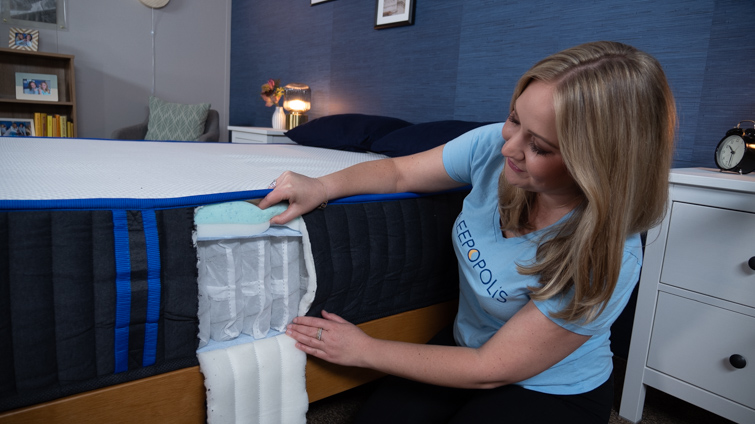
Sleeping Position
Here’s a brief overview of what mattresses might be good for the different sleeping positions.
- Back sleepers: These sleepers don’t tend to need too much from their bed and mainly need their bed to be comfortable and supportive. They usually do best on hybrid or innerspring mattresses.
- Side sleepers: Side sleepers tend to need a softer mattress in order to get nice cushioning and pressure relief for their shoulders and hips. They typically do well on foam mattresses, although they can also find a match in many hybrid beds.
- Stomach sleepers: Stomach sleepers need a firmer and more supportive mattress in order to keep their hips lifted and in line with their shoulders — ensuring healthy sleep posture. We usually steer stomach sleepers toward innerspring mattresses, although there are some hybrids that can work well for them.
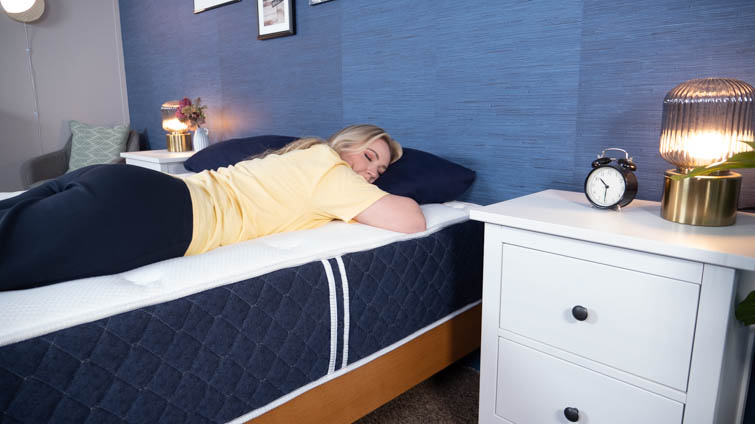
- Combination sleepers: This refers to sleepers who switch positions throughout the night. They need a responsive bed that allows them to easily move around and change sleeping positions. They typically do well on latex mattresses, hybrid mattresses, and innerspring mattresses.
Body Types
At Sleepopolis, we categorize lightweight sleepers as weighing less than 130 pounds, average-weight sleepers as weighing between 130 and 250 pounds, and heavy sleepers as weighing more than 250 pounds.
How Body Type Can Make a Difference
Beds are typically going to feel firmer to lightweight sleepers than they do heavyweight sleepers. If you’re heavier in weight, you’re also going to need more support from a bed.
We typically recommend heavier sleepers look for an innerspring mattress or on our roundup of the best mattresses for heavy people. This list consists of beds built especially for larger folks.
FAQs
What is fiberglass?
Fiberglass is a composite material made of glass and reinforced plastic. It’s used in a variety of products and places, from wall insulation to mattresses. It’s known for being very malleable, durable, and inexpensive, which is why manufacturers like to use it.
Do all mattresses have fiberglass?
No. Not all mattresses contain fiberglass. However, many do, as it’s an effective flame retardant. Fiberglass is less expensive than a lot of other options out there, which is why many companies use it.
Is fiberglass dangerous?
Fiberglass is really only dangerous if you’re directly exposed to it. If it remains beneath your mattress cover (or perhaps under a mattress protector as well), you shouldn’t have a problem with it. The issues arise when a poorly made or damaged mattress releases the glass fibers and humans come into contact with them. If this happens, the fiberglass can irritate or cause damage to people’s eyes, lungs, upper respiratory tract, or skin.
Is fiberglass in mattresses illegal?
No. It meets the federal safety standards for open-flame fire resistance in mattresses. However, it’s supposed to be completely contained and covered when it is used in beds.
Should I only purchase mattresses without fiberglass?
That’s up to you. Fiberglass can be safe to have in a mattress if it’s properly concealed, but some consumers prefer to forgo any risk of being exposed to it and buy a mattress without fiberglass instead.
What do I do if my mattress has fiberglass?
It’s important to never remove your mattress cover if the bed contains fiberglass. We also recommend adding a mattress protector to your bed for extra protection. If your bed is showing wear and tear, it’s a good idea to replace it. If its exterior is still in good shape, a good rule of thumb is to replace a mattress after five to 10 years.
How We Chose These Mattresses
Our team of Certified Sleep Science Coaches has reviewed more than 300 products in Sleepopolis’ mattress lab, running each one through tests such as pressure-mapping and measuring motion transfer with a seismometer. From there, we give every bed an overall score based on materials, comfort, support, cooling, and edge support. We also factor in brand performance with categories such as value and warranty.
For the mattresses on this page, we made sure they don’t use fiberglass in any form (or under any name) in their materials. Instead, they commit to being fiberglass-free and use other flame-retardant alternatives, like cotton, wool, rayon, latex, and proprietary blends. Click here to learn more about our methodology.
Best Mattresses Without Fiberglass 2024
| Mattress | Best For | Price (Queen) | Coupon | Review |
| Bear Original | Overall | $998 | Bear Coupon | Read Our Review |
| Helix Midnight Luxe | Back Sleepers | $2,373 | Helix Coupon | Read Our Review |
| Bear Elite Hybrid | Hybrid | $2,305 | Bear Coupon | Read Our Review |
| Helix Dawn | Stomach Sleepers | $1,374 | Helix Coupon | Read Our Review |
| Birch | Organic | $1,811 | Birch Coupon | Read Our Review |
| Emma Hybrid Comfort | Heavy Sleepers | $1,199 | Emma Coupon | Read Our Review |
| Nolah Natural | Latex | $2,099 | Nolah Coupon | Read Our Review |
| Brooklyn Bedding Aurora Luxe | Cooling | $2,265 | Brooklyn Bedding Coupon | Read Our Review |
| Plank Firm | Firm | $1,332 | Brooklyn Bedding Coupon | Read Our Review |
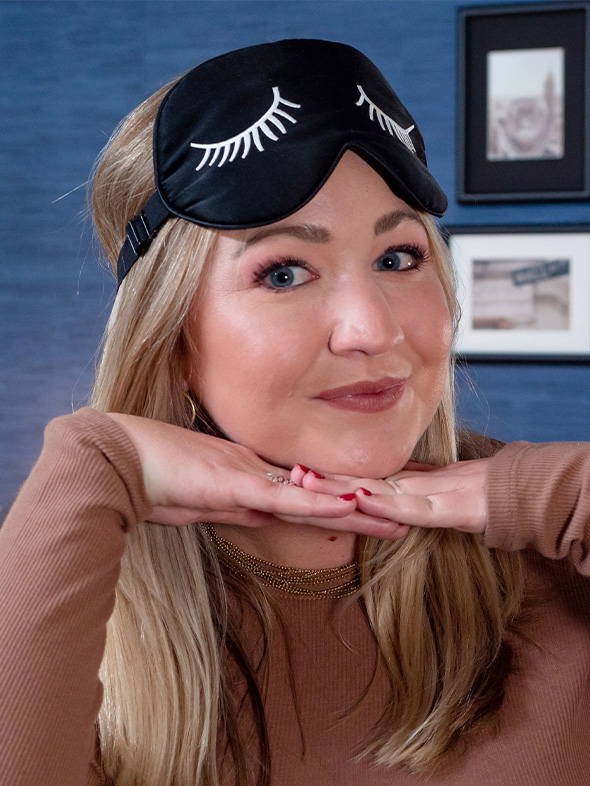
Bridget Chapman
Senior Product Editor
About Author
Bridget is a Certified Sleep Science Coach and senior editor here at Sleepopolis. From testing mattresses to writing about various sleep health topics, her goal is to help you get a good night’s sleep. You can also find her in videos on our YouTube channel. Bridget graduated magna cum laude from San Diego State University with a degree in journalism and a minor in English. Before joining the Sleepopolis team, she was a TV news reporter and worked in cities across the country. She loves spending time outdoors, checking out new restaurants, snuggling with her pets, and of course — getting some quality Zzz’s.
Combination Sleeper

